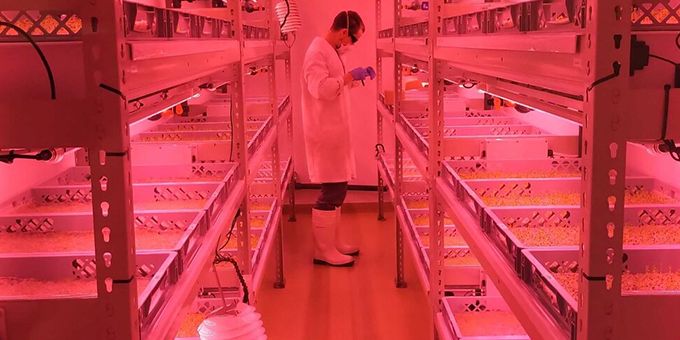Dr Antony Dodd’s research into the plant circadian clock had found that optimising growing conditions to match the clock resulted in plants that contained more chlorophyll, allowing them to convert more of the available light into biomass and grow faster.
 Developing and Improving Productivity in Vertical Farms
Developing and Improving Productivity in Vertical Farms

Article from | LettUs Grow
Growing food in our increasingly variable climate is a challenge.
Growing crops in a controlled environment provides an alternative approach to conventional farming which is free from the pressures created by extremes and variations in our weather, isolated from pests, and allows crop growth at a wider range of latitudes.
Vertical farming is a relatively recent development with the first commercial vertical farm being reported as developed in 2012 in Singapore. Grand View Research estimated that the value of the vertical farming market would reach almost US$10 billion by 2025.
Developing indoor vertical farms requires a good understanding of all the requirements each crop plant will need for optimal growth and development. As a relatively new technology, research can have a big impact on how successful these enterprises will be in the longer term with expertise in plant physiology supporting improvements to these systems.
Dr Antony Dodd’s research into the plant circadian clock had found that optimising growing conditions to match the clock resulted in plants that contained more chlorophyll, allowing them to convert more of the available light into biomass and grow faster. Experimentally, productivity could be doubled by matching the circadian rhythm to the photoperiod in the growing environment. The capacity to control conditions precisely within a vertical farm means that the environment can be fine-tuned to the requirements of the crop to maximise yield.
In 2019 Dr Antony Dodd was awarded a Royal Society Short Industry Fellowship to support the development of a collaboration with LettUs Grow. The collaborative team combines expertise in biological science with engineering, with Dr Dodd’s research group providing expertise on optimal circadian rhythms, light quality and plant physiology to inform developments in light provision for crop plants in vertical farming systems.
The team, from LettUs Grow, University of Bristol and the John Innes Centre, have worked together on several projects since the fellowship was first awarded. This has not only enabled them to develop strategies to better analyse the performance of plants within vertical farms, but also to identify the areas of research which would accelerate development of aeroponics for precision agriculture. And so together they have developed a Roadmap for aeroponics development.
The impacts so far have been:
Awarded a Royal Society Industry Fellowship supported the development of a team to develop improvements to aeroponics technology through incorporation of circadian biology and plant physiology
-
Development of a roadmap to inform on what future research is required to accelerate sustainable growth in vertical farming using aeroponics, reducing operational costs whilst maximising productivity
-
BBSRC funding has supported two studentship schemes to help LettUs Grow improve their processes to optimise lighting regimes for crop growth
Jack Farmer, Chief Scientific Officer and co-founder of LettUs Grow said: “Vertical farming is an emerging industry with a lot to offer that, alongside both greenhouse and organic agricultural practices, offers a potential pathway towards continuing to meet the worlds demand for nutritious produce without degrading large tracts of agricultural land. In many ways, each of these attempt to move forward from the chemically-driven intensive agricultural practices of the recent decades towards a system that factors-in environmental externalities.
However, if we want to manifest the environmental benefits vertical farming has to offer, we need to maximise productivity and efficiency for growers. We know it is important as a technology provider to collaborate with the best plant scientists to get the most out of our systems – elegant engineering will only take you so far. Internal collaboration between growers, engineers and scientists is foundational to what we do here, and it’s been a real pleasure to expand that collaboration to include the talented staff at the John Innes Centre.”
LettUs Grow are now developing systems to allow growth of crops which are more technically challenging such as strawberries and tree whips through their award-winning aeroponic system, which is already being used to produce leafy green crops such as salads and herbs.
There are numerous benefits to be gained from growing crops in vertical farms. We are better able to keep out pests and disease reducing the requirement for pesticides, we can maintain an optimum environment for efficient plant growth which speeds up time to harvest and enables more accurate scheduling of crops thereby reducing food waste. Vertical farms can be located close to urban conurbations reducing food miles and year-round production means that we can become less reliant on imports, guaranteeing local food supply chains which in turn can stabilise prices as well as product consistency.
Next steps for further impact from this research will involve tackling the knowledge gaps identified in the roadmap and implementing changes to identify key growing formulae for specific crops which will allow vertical farming businesses to become more productive. This in turn will enable the potential benefits of vertical farming to be fully realised.
The content & opinions in this article are the author’s and do not necessarily represent the views of AgriTechTomorrow
Comments (0)
This post does not have any comments. Be the first to leave a comment below.
Featured Product

